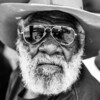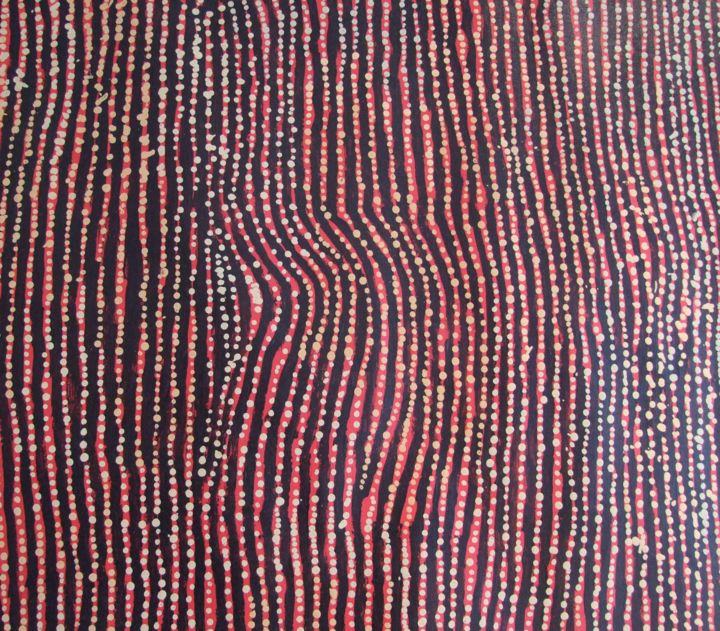
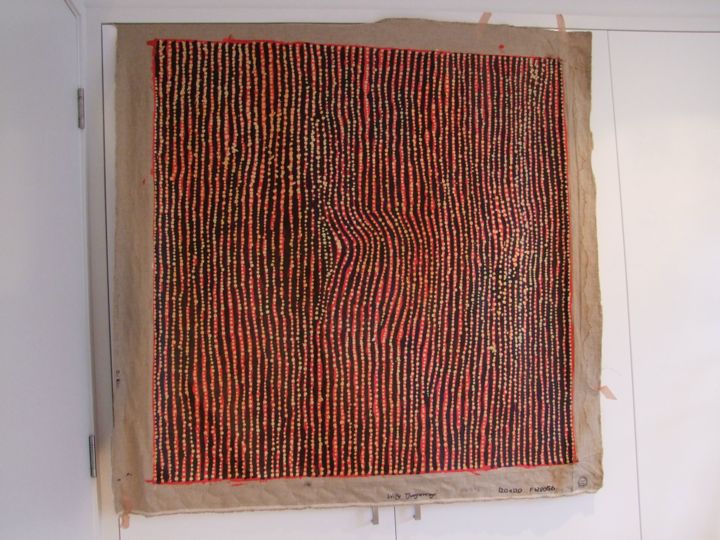
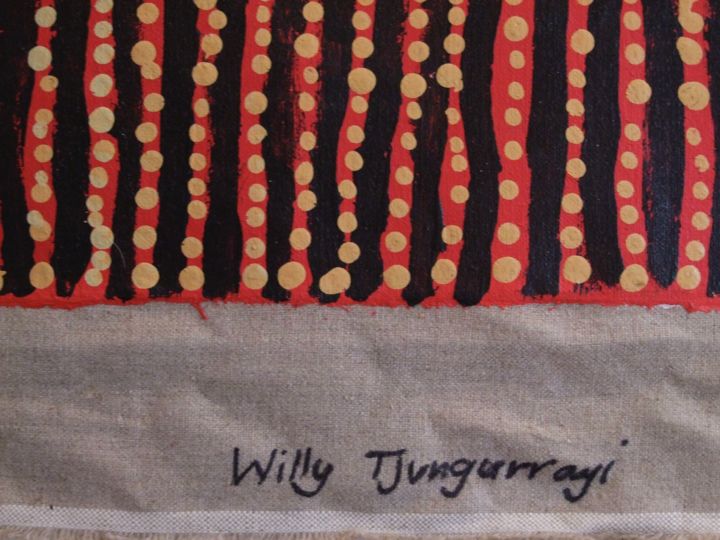
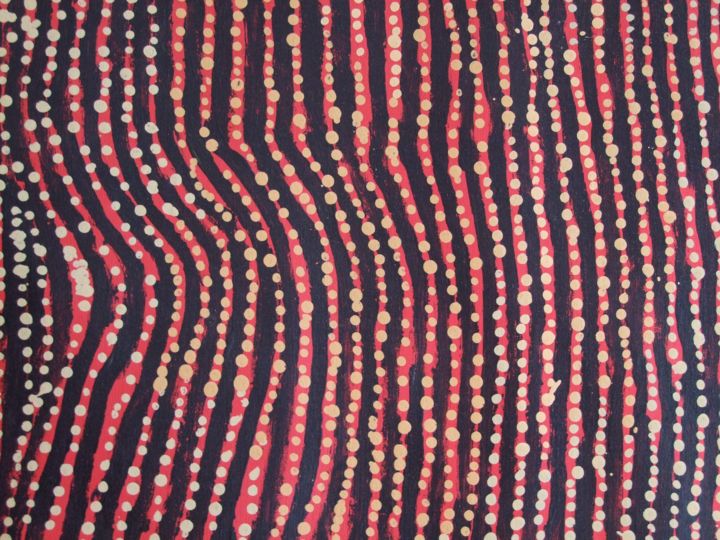


Tingari (2005) 绘画 由 Willy Tjungarrayi
-
原创艺术品 (One Of A Kind)
绘画,
丙烯
在亚麻帆布上
- 外形尺寸 高度 47.2in, 宽度 47.2in
- 是否含画框 此作品未装裱
- 分类 画作 低于US$20,000 抽象主义
"Tingari"
Painted in 2005
Size 120 cms by 120 cms
Acrylic on linen
Full Certificate of Authenticity and work in progress images
This is a HIGHLY COLLECTIBLE painting from one of the masters of Australian Aboriginal art.
It is classic old style Willy Tjungurrayi. It is a totally stunning work which is offered for sale after being in my collection for over ten years. It comes with excellent provenance and is guaranteed to be painted in 2005 by Willy Tjungurrayi. Subject to full refund on return if not as pictured or described.
Willy's works have been recently collected by Steve Martin, the American comedian and are eagerly sought after.
Willy Tjungurrayi 1932 - 2018
Born: Patjantji, Northern Territory of Australia
Language Group: Pintupi
Community: Kintore
One of the most sought-after painters of the Western Desert, Willy Tjungurrayi was a senior Pintupi man, entitled by his ancestry and communal position to paint the sacred and secret Tingari cycle. He has been acknowledged as one of the great colourists of contemporary Aboriginal painting.
Willy was in the middle one of three brothers; Yala Yala Gibbs (founding member of the Papunya art movement and senior custodian of secret/sacred men business) was the eldest and George Ward Tjungurrayi the youngest. They were all sons of Pulpalpulpalnga Tjapaltjarri but had different mothers.
Willy Tjungurrayi was born around 1932 at Patjantja, southwest of Lake Mackay in the Northern Territory. He came into Haast's Bluff in 1956 with other Pintupi people, and in 1959 Willy was trucked across to Papunya with most of the other Aboriginal residents due to problems with Haasts Bluff's water supply. Willy began painting for Papunya Tula Artists in 1976. By the 1980s Willy was recognized as a senior Pintupi painter, and he joined the movement of return to the Pintupi homelands. He lived in Walungurru (Kintore) until 2003 and split his time between Alice Springs and Walungurru.
Stories from the Tingari Dreaming song cycle, and the land around Haast's Bluff, Wilkinkarra (Lake Mackay) and Kaakuratintja (Lake MacDonald), were Willy Tjungarrayi's two great linked themes. For some subjects Willy painted dozens of dotted Roundels (concentric circles), linked by parallel lines, the spaces between them filled with bright, flat primary and mixed colours, a depiction of the travels and stopping places of the Tingari Men, an image of the rhythmic repetition of the songs associated with the Tjukurpa (Creation era or Dreaming).
More recently, Tjungarrayi's paintings featured hundreds of endless wavy lines in an ochre monochrome shimmer across the canvas on a pale background. These paintings illustrate (or witness, might be more correct) the sand hills and the fierce hailstorm that killed the ancestral Tingari Men in the Dreamtime. Willy Tjungarrayi's work is highly sought after, and has been acquired for many major private and public collections.
Some of the galleries that exhibit Willy's paintings -
Aboriginal Art Museum, The Netherlands
Artbank, Sydney
Art Gallery of New South Wales, Sydney
Flinders University Art Museum, Adelaide
National Gallery of Australia, Canberra
Parliament House Art Collection, Canberra
The Holmes a Court Collection, Perth
The Kelton Foundation, Santa Monica
Hank Ebes Collection, Melbourne
The Luczo Family Collection, USA
Corrigan Collection, Sydney
Selected Exhibitions -
2019 Desert Painters of Australia, Larry Gagosian Gallery, New York, USA - from the Steve Martin & Anne Springfield Collections and Kluge-Ruhe Collection of the University of Virginia, USA
2019 Defining Tradition: the first wave & its disciples, Kate Owen Gallery, Sydney
2017 Constellation, Paul Johnstone Gallery, Darwin
2010 Lost Tribe, Kate Owen Gallery, Sydney
2004 Papunya Tula Artists, Gallery Gabrielle Pizzi, Melbourne
2004 Australian Aboriginal Art Collector's Exhibition, Flinders Lane Gallery, Melbourne
2003 Kintore Kiwirrkura, Gallery Gabrielle Pizzi, Melbourne
1994 Central Australian Aboriginal Art and Craft Exhibition, Araluen Centre, Alice Springs
1994 Yiribana, Art Gallery of New South Wales, Sydney
1991 The Painted Dream: Contemporary Aboriginal Paintings from the Tim and Vivien Johnson Collection, Auckland City Art Gallery and Te Whare Taonga o Aoteroa National Art Gallery, New Zealand.
1989 Aboriginal Art: The Continuing Tradition, National Gallery of Australia, Canberra
1988 Australian Aboriginal Graphics from the Collection of the Flinders University Art Museum, Adelaide
1987 Art and Aboriginality, Aspex Gallery, Portsmouth, UK
1985 Dot and Circle, a retrospective survey of the Aboriginal acrylic paintings of Central Australia, Royal Melbourne Institute of Technology, Melbourne.
1983 Papunya: paintings from the Central Australian Desert, touring exhibition, America and Europe.
1982 Georges Gallery, Melbourne; Brisbane Festival; Mori Gallery, Sydney.
相关主题
Willy TjungarrayiAboriginal ArtDot PaintingAustralian ArtAustralian Paintings
Willy Tjungurrayi(约1932-2018)是西部沙漠艺术领域的杰出人物,也是最令人垂涎的画家之一,因其在描绘神圣而秘密的廷加里循环方面的精湛技艺而受到认可。作为一名资深的平图皮人,威利拥有祖先和社区的特权来描绘这些深刻的梦想故事,并赢得了当代原住民绘画伟大色彩学家之一的赞誉。
威利·琼古拉伊 (Willy Tjungurrayi) 于 1932 年左右出生于北领地麦凯湖西南部的帕特詹贾 (Patjantja),1956 年与其他平图皮人一起迁移到哈斯特崖 (Haast's Bluff)。 1959年,由于供水问题,他与大多数原住民一起搬迁到帕普尼亚。 1976 年,威利与帕普尼亚图拉艺术家一起开始了他的艺术之旅,成为这一新兴运动的重要组成部分。
到了 20 世纪 80 年代,威利·琼古拉伊 (Willy Tjungurrayi) 已晋升为高级平图皮画家,积极参与回归平图皮家园的活动。 2003 年之前,他一直居住在 Walungurru(Kintore),后来在爱丽丝泉和 Walungurru 之间度过了一段时间。
威利的艺术曲目主要集中在《Tingari Dreaming》歌曲组以及哈斯特崖、Wilkinkarra(麦凯湖)和 Kaakuratintja(麦克唐纳湖)周围的风景。他的艺术的一个显着特点是通过点状圆形图案描绘廷加里人的旅行和休息场所,这些圆形图案由平行线连接,并装饰有充满活力的原色和混合颜色。这种错综复杂的意象象征着 Tjukurpa 有节奏的重复,概括了创世时代或梦想的本质。
在最近的作品中,Willy Tjungurrayi 的画作转向展示数百条无尽的赭色单色波浪线,在苍白的背景下在画布上创造出迷人的微光。这些作品是沙山和猛烈冰雹的视觉见证,根据梦幻时代的传说,冰雹导致了廷加里人祖先的灭亡。
Willy Tjungurrayi 对土著艺术的贡献使他的作品备受追捧,在众多主要私人和公共收藏中占有一席之地。









